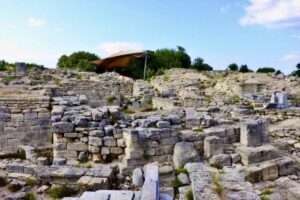
For most of us, ancient Troy brings to mind a besieged, almost mythical legendary city that in the end finally fell in a dramatic, fiery and violent battle to the Achaeans, a massive Aegean military force assembled and executed, according to the ancient Greek author Homer, for one purpose — to force the return of Helen, the (from the Achaean perspective) abducted wife of Sparta’s King Menelaus.
Scholars suggest that, beyond Homer’s myth and legend, there was a historical basis for the city. Many of them identify the archaeological remains excavated at the Hisarlik hill or tell near the northwest coast of modern day Turkey as evidence for the storied city. The first excavations began in 1871 with Heinrich Schliemann and Frank Calvert. The combination of succeeding excavations eventually revealed nine major layers and 46 strata, the first and earliest dating to the Early Bronze Age and the latest to the Byzantine era.
But recent investigations are showing that the city, contrary to its popular conception as a magnificent, isolated enclave at the edge of the Aegean, was actually part of a much larger civilization and culture.
“A recently published scientific study argues that Troy was not an isolated outpost on the wrong – non-European – side of the Aegean Sea,” writes Eberhard Zangger, a Swiss geoarchaeologist who has devoted many years of research on ancient settlements in western Turkey. “Instead,” Zangger suggests, “the city was embedded in a long-lasting and influential culture, which, however, has hardly been investigated so far.”
In his recently published article, “Ancient Troy and its Neighbors: Acknowledging the Luwian Culture at Last”, Zangger relates the efforts of 33 archaeological excavations and 30 archaeological surveys that have resulted in a catalog of 477 settlements representing a culture that “is not indicated on maps”. Troy, he postulates, was a part of this ancient civilization and culture. Moreover, he suggests that this culture may have played a major role among the “Sea Peoples” who are hypothesized by some scholars to have contributed to the great Late Bronze Age collapse.
_______________________________

The excavated walls of ancient Troy. Ebru Sargın L.,Creative Commons Attribution-Share Alike 4.0 International, Wikimedia Commons
_______________________________
More about the research can be obtained in the article, Ancient Troy and its Neighbors: Acknowledging the Luwian Culture at Last, published in the fall 2022 issue of Popular Archaeology Magazine.
_______________________________
Advertisement


